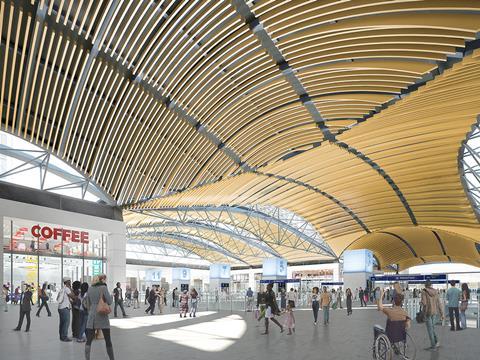
UK: An agenda for the Transport for London board meeting on February 5, issued in late January, indicates that the Department for Transport intends to proceed with changes to the layout of the High Speed 2 terminus at London Euston and the construction phasing.
The agenda says TfL ‘continues to provide input into the DfT-led study on proposals for Euston following publication of the Oakervee Review in 2020. DfT has recently instructed HS2 Ltd to proceed with further design development for one of the options, which provides a solution based around 10 HS2 platforms, a single stage build and increased oversite development.’
The Oakervee Review, published in February last year, recommended to government that the plans for the 540 route-km, Y-shaped HS2 network linking London with the West Midlands and northern England be delivered in full, subject to further integration with proposed major rail schemes in the north.

However, more recently there has been concern that some elements of HS2 may be descoped, principally affecting the Phase 2b Eastern Leg which would link Birmingham with Leeds, York and the East Coast Main Line. The HS2 business case envisages that as well as linking the northeast with the East Midlands and Birmingham, this route would also carry express services between Newcastle and London, thereby relieving capacity constraints on the ECML south of York.
A report issued by the National Infrastructure Commission on December 15 outlining its assessment of rail investment needs across the Midlands and northern England recommended curtailing much of the Eastern Leg, leaving a short spur between the Birmingham area and a junction with the Midland Main Line near the existing East Midlands Parkway station; trains towards Sheffield and Nottingham would then continue over existing tracks. NIC suggested that ongoing enhancement of the ECML could cater for future growth in traffic between the northeast and London.
The Euston challenge
The news of DfT’s recommended reduction in the number of platforms at Euston appears to reinforce this approach.
Redevelopment of the terminus has proved hugely challenging for HS2 Ltd and its partners over the past decade. The initial objective when the first phase of HS2 received Royal Assent in 2017 had been to build six new high speed platforms and a concourse to the west of the existing station to open by 2026, with five of the existing 18 platforms subsequently being rebuilt for high speed use, including an extended concourse to support Phase 2 services in 2026-33. Under the revised plans, this two-stage construction of 11 platforms would be replaced by a single build of 10 platforms.
HS2 trains are now expected to terminate for the first few years at Old Oak Common in west London, where there will be an interchange with the Elizabeth Line to provide connections to the city centre and Heathrow Airport.

While HS2 has been specified from the outset to accommodate 18 trains/h in each direction on the ‘core’ between the West Midlands and London, with a maximum of 17 paths used at peak times, the Oakervee Review had recommended reducing throughput to 14 trains/h with ‘passive provision’ for 16 in the future. Industry insiders have questioned whether this will be achievable with 10 dedicated platforms at Euston, particularly if the planned grade-separated approach tracks are also simplified.
Anger in the Midlands
Meanwhile, the continued doubt over delivery of the Phase 2b Eastern Leg following publication of the NIC assessment has drawn an angry response from regional policymakers. Leader of Nottinghamshire County Council Kay Cutts, Sheffield City Region Mayor Dan Jarvis and Judith Blake, Leader of Leeds City Council, all co-signed a letter to Prime Minister Boris Johnson in mid-January to urge him to reject the NIC’s findings.
‘The substandard options set out in the Rail Needs Assessment publication completely failed to achieve the remit you set for them; to set out how major projects in the north and Midlands, including northern parts of HS2, Northern Powerhouse Rail, Midlands Engine Rail and trans-Pennine upgrades, can be fully delivered’, the leaders wrote. ‘We wholeheartedly reject that report and urge the government to do the same. The NIC report is not fit for purpose – they were tasked with integrating these projects, not pitting them against each other.’

Speaking to Rail Business UK on January 25, Director of the Midlands Connect group of business leaders and local authorities Maria Machancoses explained that ‘the NIC report did not acknowledge at all the wider benefits of HS2, which is what the previous review by Douglas Oakervee highlighted time and time again. He said that you need to look at it in terms of the wider benefits and proposals around Toton station, proposals around Sheffield, Leeds. All of these are well underway, a lot of effort has been put in place and a lot of interest has been expressed from private investors because they knew those were the proposals; even if it was done 10 or 15 years down the line they knew it was coming.’
Machancoses again called for action rather than for more time to be wasted considering what to do next. ‘We really don’t want another review; it’s not fair for those communities who are already been affected by all of this. I’m not talking only from a transport perspective, it’s not fair for those communities who are trying to move on and plan. This attitude will not help the economic recovery of the area at all.’



